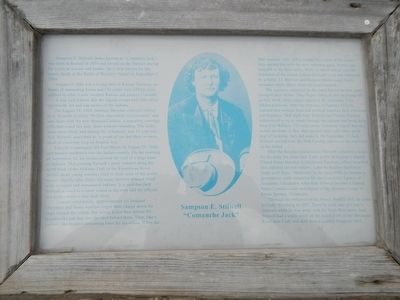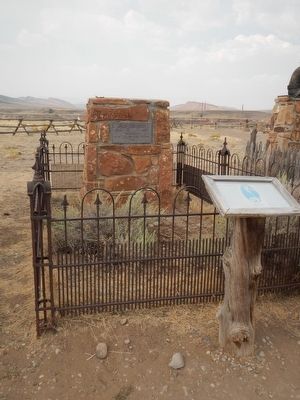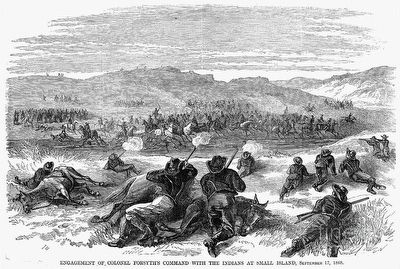Cody in Park County, Wyoming — The American West (Mountains)
Sampson E. Stilwell
"Comanche Jack"
Sampson E. Stilwell, better known as "Comanche Jack," was born in Kansas in 1850 and served on the frontier during his youth as a scout and hunter. He is best known for his heroic deeds at the Battle of Beechers Island on September 6 (sic), 1868.
August of 1886 was a trying time in Kansas Territory, as bands of marauding Sioux and Cheyenne were killing many settlers in what is now western Kansas and eastern Colorado.
It was well-known that the regular troops had little effect against the hit-and-run tactics of the Indians.
On August 24, 1868, General Sheridan ordered Colonel G.A. Forsyth to enlist "50 first class hardy frontiersmen" and arm them with the new Spencer Carbine, a repeating cartridge rifle that could fire nine shots without reloading. The ranks were soon filled, and among the volunteers was 18-year-old Jack Stilwell, described as "a youth of six feet three or more, short of years but long on frontier lore."
Forsyth's contingent left Fort Hayes on August 29, 1868, and headed northwest into the Indian country. On the morning of September 16 (sic), his scouts crossed the trail of a large band of Indians. That evening Forsyth's party camped along the north bank of the Arikaree Fork of the Republican River. Before dawn young warriors tried to steal some of the scouts horses. Shortly after dawn, the entire horizon seemed filled with mounted and unmounted Indians. It is said that Jack Stilwell pointed to a small island in the river and the officers and scouts made a mad dash for it.
Almost immediately, approximately six hundred Cheyenne and Sioux warriors began their charge down the slope toward the island. The scouts killed their horsed for breastworks and dug into the sand behind them. Then, like a cyclone, the massive screaming force hit the island. When the first warriors were within twenty-five yards of the scouts, they opened fire with the new repeating guns. Horses and men fell in the first volley, many of which rolled over the defenders of the island. Colonel Forsyth's leg was shattered by a bullet, Lt. Beecher and Surgeon Moore were fatally wounded while others received lesser wounds.
The warriors, surprised by the rapid fire of the new guns, changed their tactics. They began riding and swerving off as they fired, while others sniped at the defenders from hidden positions. After the first day of fighting Forsyth realized that without food and medical supplies their situation was hopeless. That night Jack Stilwell and Pierre Trudeau volunteered to try to sneak through the Indians and bring help from Fort Wallace, 125 miles away. Everyone feared that they would not make it. But after several close calls and a great deal of hardship, they did make it. On September 15 Jack Stilwell arrived with the 10th Cavalry and saved the survivors on the Island.
After the Beechers Island battle, Stilwell remained a scout for the army for some time. Later in life he became a deputy United States Marshal in Oklahoma Territory, where he killed and captured several outlaws. Later he became the Police Judge at El Reno, Oklahoma. In the mid-1890s he became a government cattle inspector for the Comanche Agency at Anadarko, Oklahoma. After that, Stilwell became United States Commissioner and Master of the Masonic Lodge at Erwin Springs, Oklahoma.
Through the influence of his friend, Buffalo Bill, he came to Cody, Wyoming in 1897. There he took care of Cody's interests while he was away with the Wild West show. Jack Stilwell had a small ranch on the South Fork of the Shoshone River near Cody and died from a sudden illness in 1903.
Erected by Old Trail Town.
Topics. This historical marker is listed in this topic list: Cemeteries & Burial Sites. A significant historical date for this entry is September 17, 1868.
Location. 44° 30.912′ N, 109° 6.316′ W. Marker is in Cody, Wyoming, in Park County. Marker can be reached from Demaris Drive near West Yellowstone Avenue (U.S. 14). Touch for map. Marker is at or near this postal address: 1831 Demaris Drive, Cody WY 82414, United States of America. Touch for directions.
Other nearby markers. At least 8 other markers are within walking distance of this marker. Phillip H. Vetter (here, next to this marker); W.A. Gallagher and Blind Bill (here, next to this marker); Jim White (here, next to this marker); John Jeremiah "Liver Eating" Johnston (a few steps from this marker); Belle Drewry (a few steps from this marker); Trail to Old Cody City (within shouting distance of this marker); Lee Street – Cody City (within shouting distance of this marker); Stone Circles (within shouting distance of this marker). Touch for a list and map of all markers in Cody.
More about this marker. This marker is located in the cemetery at the west end of Old Trail Town.
Also see . . . Battle of Beecher Island. Legends of America website entry:
On the 17th of September, 1868, was fought the hardest battle between the white men and the plains Indians in the annals of the West. It was fought on the Arickaree fork of the Republican River... Fifty-one scouts and frontiersmen under the command of Lieutenant George A. Forsyth stood off, on a little sandbar in the river, the combined forces of the Northern Cheyenne, Arapaho and Oglala Sioux for nine days. They lost more than one third their own number in killed and wounded, while the Indian loss was many times as great. (Submitted on November 29, 2015, by Barry Swackhamer of Brentwood, California.)
Credits. This page was last revised on October 28, 2021. It was originally submitted on November 29, 2015, by Barry Swackhamer of Brentwood, California. This page has been viewed 608 times since then and 41 times this year. Photos: 1, 2, 3. submitted on November 29, 2015, by Barry Swackhamer of Brentwood, California.


